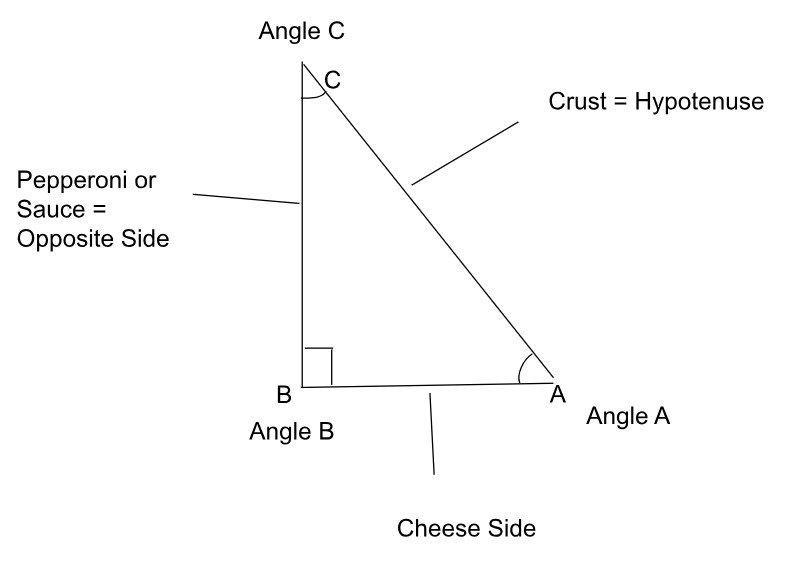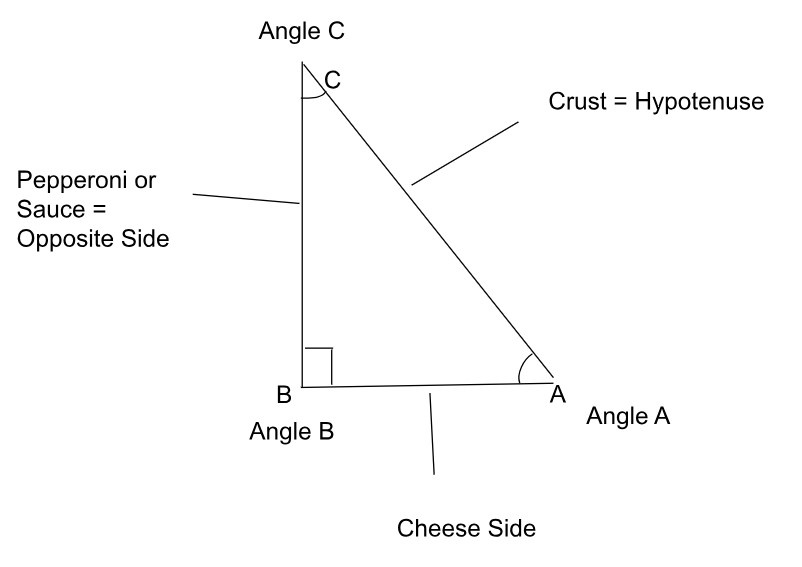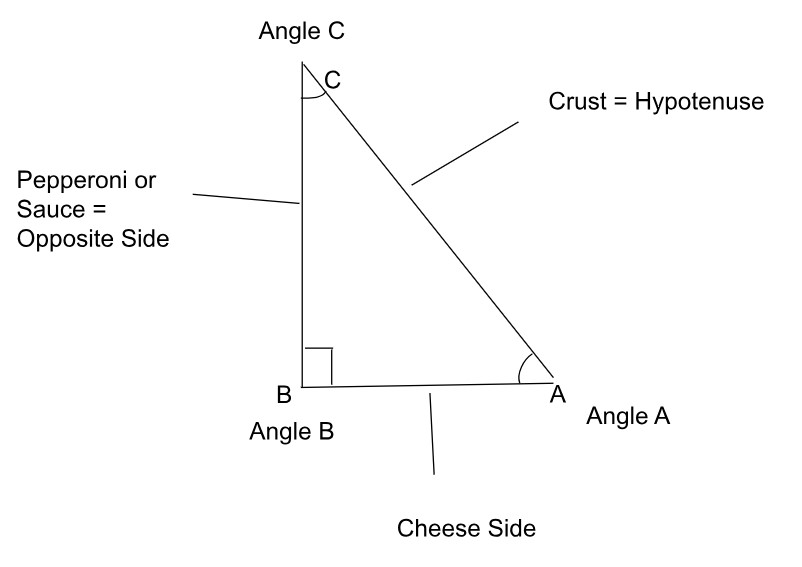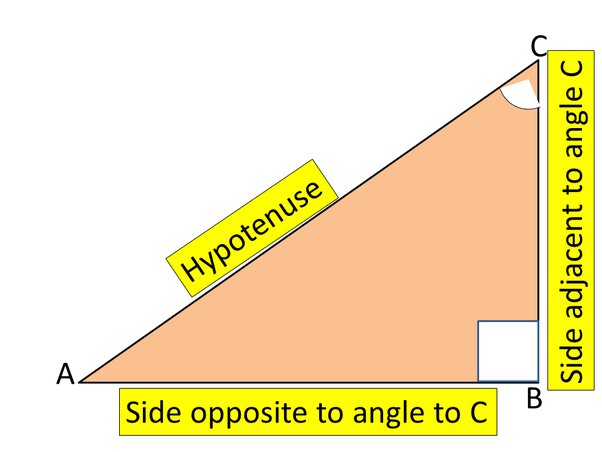Understanding Right-Angled Triangles -- Opposite & Adjacent Sides (Foundations of Angles)
To understand what is trigonometry, let us imagine a slice of pizza, which forms a perfect right triangle as shown in the below figure triangle ABC.
Hypotenuse: Here, in the triangle, you can consider that the ‘crust’ (hypotenuse) is the longest side; this is opposite to the right angle.
Opposite Side and Adjacent Sides: Now, let us draw our attention to the two non-right angles.
On the diagram, see the side facing one angle A; we can assume this to be the pepperoni/sauce side or call it the ‘opposite’ side, while the other side (think of it as the cheese side) can be called the ‘adjacent’ side.
Remember, these sides' lengths turn out to be vital ingredients when we explore angles using ratios.

Unlocking Angles with Ratios -- Trigonometric Ratios
For some children, it may be difficult to remember the trigonometric ratios. Hence, to make it simple, let us assume a tiny chef whose name is the ‘trigonometry chef.’
This chef can prepare different dishes based on his secret ingredients and we will unravel how he uses the ingredients to create special trigonometric dishes (trigonometric formulas).
So, you are welcomed to the kitchen of the ‘Trigonometry Chef,’ who uses certain secret ingredients that are opposite, adjacent, and hypotenuse. And, his famous dishes are none other than the fundamental trigonometric ratios: Sine (sin), Cosine (cos), and Tangent (tan).
As explained before, to understand the trigonometric ratios: imagine a right-angled triangle like a pizza slice. The longest side in this triangle, the crust, is the hypotenuse. The two perpendicular sides are the opposite (facing the angle you're interested in) and the adjacent (next to the angle).
Now, the chef gets creative bringing his special ingredients into play to create the dishes of Sin, Cos, and Tan, and here is how he makes them:
1. Sin (Sine of an angle, say Sin A) = Opposite/Hypotenuse: To understand this, imagine dipping the crust (hypotenuse) in marinara sauce (opposite). Hence, the resultant product Sin Theta is the ratio of the height of the triangle or opposite side (Sauce) to length (or crust).
2. Cos (Cosine of an angle, say Cos A) = Adjacent/Hypotenuse: Now, he dips the adjacent side (Sauce) in the crust (hypotenuse), and therefore, the ratio of cheese width to crust length will be the Cos Theta.
3. Tan (Tangent of an angle, say Tan A) = Opposite/Adjacent: Picture mixing a pepperoni/sauce (opposite side) into the cheese (adjacent side). The resultant product is Tan Theta which is the ratio of the height of the triangle (Sauce) to the length (or cheese).
These ratios, depending on the angle you choose, when used smartly can help to unlock a treasure stash of information about triangles and beyond! Importantly, by using these simple recipes, even 10th-standard CBSE students can turn into trigonometry whizzes!
Cosecant: This angle, also referred to as Cosec A or Csc A, helps to understand the relationship between the hypotenuse (AC, the longest side) and the opposite side (BC, the side opposite the angle A).

You can think of Cosecant as the ultimate opposite buddy -- it's like saying, 'Hey opposite, how small are you compared to the big boss hypotenuse?' and the formula is Cosec A = AC/BC.
To remember it, you can also imagine a chef tossing pizza dough in the air and if it is tossed in such a manner that we have a longer hypotenuse and a shorter opposite side, then the cosecant value will change significantly.
Secant: This angle, also going by the name as Secant A or Sec A, focuses on the hypotenuse (AC) and the adjacent side (AB, the side next to the angle A).

To understand it, you imagine a scenario wherein you're standing on a street corner, more like a detective who is trying to crack the case of the missing angles.
Suddenly, you come across a tall building -- reaching way up into the sky. Now, you are interested to know how far away is the building from where you're standing.
Secant is like your super secret measuring tool that uses the hypotenuse (the longest side of a right triangle) and the adjacent side, the side next to the angle you're interested in.
It's like asking, 'How many detective steps does it take me to reach the building compared to the distance right next to it?' and you can find it with the formula: Sec A = AC/AB.
Another way to remember the same is by visualizing that tall chef tossing the pizza. If he stretches his arm higher (longer hypotenuse), the pizza slice appears smaller (shorter adjacent side), making the secant value larger.
Cotangent: Finally, when it comes to the cotangent, it is written as Cot A in short form, and it compares the adjacent side (AB) to the opposite side (BC).
It's like the ratio of the pizza crust (adjacent side) to the delicious toppings (opposite side) -- chill cousins and the formula is Cot A = AB/BC.
By calculating it you will come to know how much 'ground' (adjacent side) you cover for every step 'up' (opposite side) you take on your angle adventure!
Conclusion
Understanding the basics of trigonometry that is Sine, Cosine, Tangent, Cosine, Secant, and Cotangent is very important as it would help us to calculate the height, base, or hypotenuse of a triangle if any of two variables are present, and it forms the basics of the trigonometric ratios.
If you as a school or institute are interested in creating videos, simulations, or creating digital simplified text related to these or other topics, you can contact Nobel Learn.


